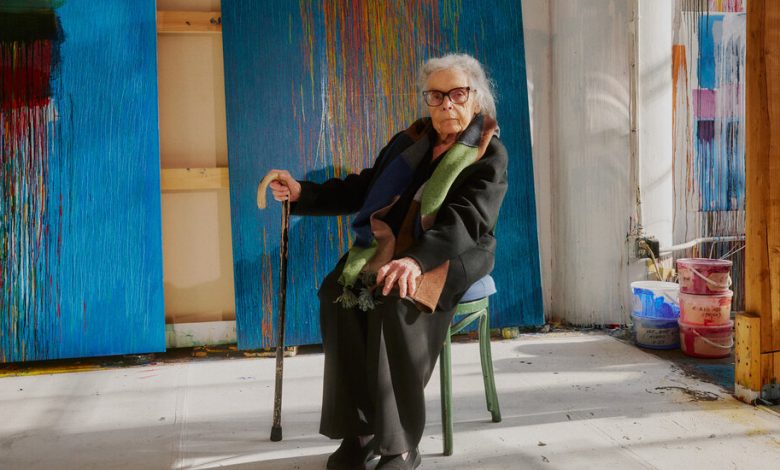Pat Steir’s Blue Period

A stack of yellow and red bands drip from the top of “Painted Rain #3” (2022-23), a painting by the artist Pat Steir. Coalescing against a bright turquoise backdrop with layers of poured-on paint, the combination imbues the artwork with the sense that you’re peering into a sun shower. Hanging vertically at nine feet, the monumental canvas is part of a new series by Steir — on view at Hauser & Wirth’s West Hollywood gallery —dedicated to the color blue, an exploration that was catalyzed in part by a visit to a “very thorough” ophthalmologist eight years ago, says Steir, 85. “He gave me a color [vision] test and, when he was done, he said, ‘You’re colorblind. You can’t see the color blue,’” she recalls. The diagnosis was not entirely surprising — Steirknew she struggled to discern certain shades from others — but as an artist whose experiments with gesture and color have helped to redefine the canon, the confirmation set her on a new path. She began to scrupulously mix her paints to achieve subtly different hues, then unleashed them on her canvases. “Now I can see many kinds of blue,” she says.
The canvas “Painted Rain #5” (2022-23), another work from the series, resembles the scene at Steir’s studio when I meet her there one cold evening in February. The painting’s velvety midnight blue backdrop is lit with strokes of brilliant orange and deep jewel tones, which seem to emulate the water of the Hudson River outside her window, rippled and purple as a date, when it reflects the artificial light emanating from a nearby apartment complex. One of many units in a colossal building in New York’s Chelsea neighborhood, her work space is vast and airy. At its center rests a wooden table atop which she has organized her paints into neatly labeled plastic buckets. Sitting below the desk are cartons of Turpenoid, a thin and odorless turpentine substitute that Steir uses to dilute her pigments. She tests her concoctions directly on the walls of the studio, and one such surface resembles a grand quilt, blanketed with bleeding swatches of mustard, maroon and, of course, blue.
Steir moved her work space in 2004, and she’s quick to point out how things have changed over the years. “Before they built these buildings, I could see all the way to the George Washington Bridge,” she says, lamenting the loss of natural light. The artist turns to nature as a perennial inspiration for her paintings, which tend to evoke seaside landscapes and rushing rivers with their showers of flicked and dripped pigment. And though she has exhibited widely since the ’60s — her first solo show was at the Terry Dintenfass Gallery in New York in 1964 — the work that has come to define her practice, her “Waterfall” paintings, wasn’t developed until the late ’80s, in a studio in SoHo just a few miles south from where she is now. To create the first work in the series, “Sixteen Waterfalls of Dreams, Memories, and Sentiment” (1990), Steir stood atop a ladder and poured paint onto an unstretched canvas, allowing gravity, time and the weight of the paint to decide where the color eventually landed. The finished piece, versions of which she went on to make by flinging and throwing paint, is now in the collection of the Metropolitan Museum of Art.
Steir no longer works while balancing on a ladder. An accident in her Greenwich Village home in 2019 left her with mobility issues for which she continues to see a physical therapist; she answers T’s Artist’s Questionnaire with a cane within reach. Yet painting remains an integral physical and even spiritual exercise for the artist. Today she reaches the peak of her canvases by riding a scissor lift, which sits behind her worktable, its metal bars speckled with globs of paint in many different colors.




